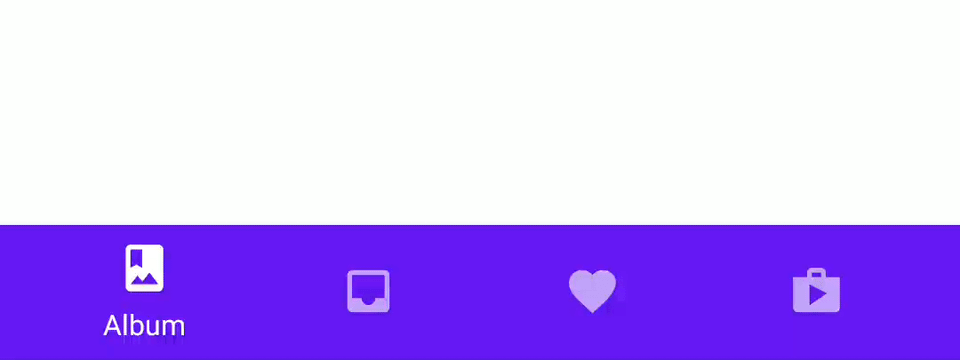A material-design themed tab bar on the bottom of the screen that lets you switch between different routes with animation. Routes are lazily initialized – their screen components are not mounted until they are first focused.
This wraps the BottomNavigation component from react-native-paper. If you configure the Babel plugin, it won’t include the whole react-native-paper library in your bundle.

To use this navigator, ensure that you have @react-navigation/native and its dependencies (follow this guide), then install @react-navigation/material-bottom-tabs:
- npm
- Yarn
Copynpm install @react-navigation/material-bottom-tabs react-native-paper
This API also requires that you install react-native-vector-icons! If you are using Expo, it will just work out of the box. Otherwise, follow these installation instructions.
To use this tab navigator, import it from @react-navigation/material-bottom-tabs
API Definition#
To use this tab navigator, import it from @react-navigation/material-bottom-tabs:Copyimport { createMaterialBottomTabNavigator } from ‘@react-navigation/material-bottom-tabs’; const Tab = createMaterialBottomTabNavigator(); function MyTabs() { return ( <Tab.Navigator> <Tab.Screen name=”Home” component={HomeScreen} /> <Tab.Screen name=”Settings” component={SettingsScreen} /> </Tab.Navigator> );}Try this example on Snack
For a complete usage guide please visit Tab Navigation
RouteConfigs#
The route configs object is a mapping from route name to a route config.
Props#
The Tab.Navigator component accepts following props:
initialRouteName#
The name of the route to render on first load of the navigator.
screenOptions#
Default options to use for the screens in the navigator.
backBehavior#
Behavior of back button handling.
initialRouteto return to initial taborderto return to previous tab (in the order they are shown in the tab bar)historyto return to last visited tabnoneto not handle back button
shifting#
Whether the shifting style is used, the active tab icon shifts up to show the label and the inactive tabs won’t have a label.
By default, this is true when you have more than 3 tabs. Pass shifting={false} to explicitly disable this animation, or shifting={true} to always use this animation.
labeled#
Whether to show labels in tabs. When false, only icons will be displayed.
activeColor#
Custom color for icon and label in the active tab.
inactiveColor#
Custom color for icon and label in the inactive tab.
barStyle#
Style for the bottom navigation bar. You can pass custom background color here:Copy<Tab.Navigator initialRouteName=”Home” activeColor=”#f0edf6″ inactiveColor=”#3e2465″ barStyle={{ backgroundColor: ‘#694fad’ }}> {/* … */}</Tab.Navigator>Try this example on Snack
If you have a translucent navigation bar on Android, you can also set a bottom padding here:Copy<Tab.Navigator initialRouteName=”Home” activeColor=”#f0edf6″ inactiveColor=”#3e2465″ barStyle={{ paddingBottom: 48 }}> {/* … */}</Tab.Navigator>
Options#
The following options can be used to configure the screens in the navigator:
title#
Generic title that can be used as a fallback for headerTitle and tabBarLabel.
tabBarIcon#
Function that given { focused: boolean, color: string } returns a React.Node, to display in the tab bar.
tabBarColor#
Color for the tab bar when the tab corresponding to the screen is active. Used for the ripple effect. This is only supported when shifting is true.
tabBarLabel#
Title string of a tab displayed in the tab bar. When undefined, scene title is used. To hide, see labeled option in the previous section.
tabBarBadge#
Badge to show on the tab icon, can be true to show a dot, string or number to show text.
tabBarAccessibilityLabel#
Accessibility label for the tab button. This is read by the screen reader when the user taps the tab. It’s recommended to set this if you don’t have a label for the tab.
tabBarTestID#
ID to locate this tab button in tests.
Events#
The navigator can emit events on certain actions. Supported events are:
tabPress#
This event is fired when the user presses the tab button for the current screen in the tab bar. By default a tab press does several things:
- If the tab is not focused, tab press will focus that tab
- If the tab is already focused:
- If the screen for the tab renders a scroll view, you can use
useScrollToTopto scroll it to top - If the screen for the tab renders a stack navigator, a
popToTopaction is performed on the stack
- If the screen for the tab renders a scroll view, you can use
To prevent the default behavior, you can call event.preventDefault:CopyReact.useEffect(() => { const unsubscribe = navigation.addListener(‘tabPress’, (e) => { // Prevent default behavior e.preventDefault(); // Do something manually// … }); return unsubscribe;}, [navigation]);Try this example on Snack
Helpers#
The tab navigator adds the following methods to the navigation prop:
jumpTo#
Navigates to an existing screen in the tab navigator. The method accepts following arguments:
name– string – Name of the route to jump to.params– object – Screen params to merge into the destination route (found in the pushed screen throughroute.params).
Copynavigation.jumpTo(‘Profile’, { name: ‘Michaś’ });Try this example on Snack
Example#
Copyimport { createMaterialBottomTabNavigator } from ‘@react-navigation/material-bottom-tabs’;import MaterialCommunityIcons from ‘react-native-vector-icons/MaterialCommunityIcons’; const Tab = createMaterialBottomTabNavigator(); function MyTabs() { return ( <Tab.Navigator initialRouteName=”Feed” activeColor=”#e91e63″ style={{ backgroundColor: ‘tomato’ }} > <Tab.Screen name=”Feed” component={Feed} options={{ tabBarLabel: ‘Home’, tabBarIcon: ({ color }) => ( <MaterialCommunityIcons name=”home” color={color} size={26} /> ), }} /> <Tab.Screen name=”Notifications” component={Notifications} options={{ tabBarLabel: ‘Updates’, tabBarIcon: ({ color }) => ( <MaterialCommunityIcons name=”bell” color={color} size={26} /> ), }} /> <Tab.Screen name=”Profile” component={Profile} options={{ tabBarLabel: ‘Profile’, tabBarIcon: ({ color }) => ( <MaterialCommunityIcons name=”account” color={color} size={26} /> ), }} /> </Tab.Navigator> );}Try this example on Snack
Using with react-native-paper (optional)#
You can use the theming support in react-native-paper to customize the material bottom navigation by wrapping your app in Provider from react-native-paper. A common use case for this can be to customize the background color for the screens when your app has a dark theme. Follow the instructions on react-native-paper‘s documentation to learn how to customize the theme.
